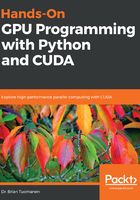
Using Amdahl's Law
We will now derive Amdahl's Law, which is a simple arithmetic formula that is used to estimate potential speed gain that may arise from parallelizing some portion of code from a serial program onto multiple processors. We will do this by continuing with our prior analogy of building a house.
Last time, we only considered the actual physical construction of the house as the entire time duration, but now, we will also consider the time it takes to design the house into the time duration for building the house. Suppose that only one person in the world has the ability to design your house—you—and it takes you 100 hours to design the plans for your house. There is no possibility that any other person on the planet can compare to your architectural brilliance, so there is no possibility that this part of the task can be split up at all between other architects—that is, so it will take 100 hours to design your house, regardless of what resources you have or how many people you can hire. So, if you have only one laborer to build your house, the entire time it will take to build your home will be 200 hours—100 hours for you to design it, and 100 hours for a single laborer to build it. If we hire two laborers, this will take 150 hours—the time to design the house will remain at 100 hours, while the construction will take 50 hours. It's clear that the total number of hours to construct the house will be 100 + 100 / N, where N is the number of laborers we hire.
Now, let's step back and think about how much time building the house takes if we hire one laborer—we ultimately use this to determine speedup as we hire additional laborers; that is, how many times faster the process becomes. If we hire a single laborer, we see that it takes the same amount of time to both design and construct the house—100 hours. So, we can say that that the portion of time spent on the design is .5 (50%), and the portion of the time it takes to construct the house is .5 (50%)—of course, both of these portions add up to 1, that is 100%. We want to make comparisons to this as we add laborers—if we have two laborers, the portion of time for the construction is halved, so in comparison to the original serial version of our task, this will take .5 + .5/2 = .75 (75%) of the time of the original task, and .75 x 200 hours is 150 hours, so we can see that this works. Moreover, we can see that if we have N laborers, we can calculate the percentage of time our parallelized construction with N laborers will take which the formula .5 + .5 / N.
Now, let's determine the speedup we are gaining by adding additional laborers. Since it takes 75% of the time to build a house if we have two laborers, we can take the reciprocal of .75 to determine the speedup of our parallelization—that is, the speedup will be 1 / .75, which is around 1.33 times faster than if we only have one laborer. In this case, we see that the speedup will be 1 / (.5 + .5 / N) if we have N laborers.
We know that .5 / N will shrink very close to 0 as we add more and more laborers, so we can see there is always an upper bound on the speedup you can get when you parallelize this task—that is, 1 / (.5 + 0) = 2. We can divide the original serial time with the estimated maximum speedup to determine an absolute minimum amount of time this task will take—200 / 2 = 100 hours.
The principle we have just applied to determine speedups in parallel programming is known as Amdahl's Law. It only requires knowledge of the parallelizable proportion of execution time for code in our original serial program, which is referred to as p, and the number of processor cores N that we have available.
We can now calculate speedup with Amdahl's Law as follows:

To sum it up, Amdahl's Law is a simple formula that allows us to roughly (very roughly) estimate potential speedup for a program that can be at least partially parallelized. This can provide a general idea as to whether it will be worthwhile to write a parallel version of a particular serial program, provided we know what proportion of the code we can parallelize (p), and how many cores we can run our parallelized code on (N).